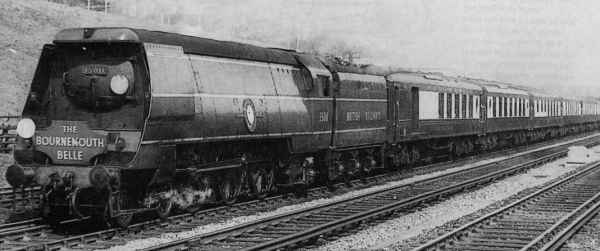|
35012 United States Lines |
|||||||||||||||||||||||||||||||||||||||||||||||||||||||||||||||||||||||||||||||||||||||||||||||||||||||||||||||||||||||||||||||||||||||||||||||||||||||||||||||||||||||||||||||||||||||||||||||||||||||||||||||||||||||||||||||||||||||||
|
|
|||||||||||||||||||||||||||||||||||||||||||||||||||||||||||||||||||||||||||||||||||||||||||||||||||||||||||||||||||||||||||||||||||||||||||||||||||||||||||||||||||||||||||||||||||||||||||||||||||||||||||||||||||||||||||||||||||||||||
| RETURN TO THE HOMEPAGE
S/S UNITED STATES
|
|||||||||||||||||||||||||||||||||||||||||||||||||||||||||||||||||||||||||||||||||||||||||||||||||||||||||||||||||||||||||||||||||||||||||||||||||||||||||||||||||||||||||||||||||||||||||||||||||||||||||||||||||||||||||||||||||||||||||
|
35012 United States Lines and the SR Bullied “Merchant Navy” class 4-6-2 steam locomotives The Fleet:
Brief History:
21C11 / 35011 General Steam Navigation, showing the Merchant Navy class in its original air smoothed condition. When Oliver Vaughan Snell Bulleid took over as Chief Mechanical Engineer of the Southern Railway in 1937, the outlook for steam traction looked bleak. In the five years from 1932, the Southern had concentrated much of its efforts on further electrification. However, there was much of the Railway's territory that still relied on steam traction. The "Lord Nelson"' class of 1926 was not all it was intended to be and the "King Arthur" class, dating back to 1918, was not of the power class really required, particularly for the heavy boat trains. After some early work designed to improve the existing steam fleet Bulleid set about the task of designing a new locomotive. Engines were required to haul 550 to 600 ton trains at 70 miles per hour on the Western Section and the heavy Continental Boat Trains at 60 mph. After 4-8-2 and 2-8-2 designs had been rejected as being too heavy by the Civil Engineer, Bulleid opted for the "Pacific" wheel arrangement - 4-6-2. These locomotives were introduced in 1941 by the Southern Railway to a design by Oliver Bulleid the first one being 21C1 Channel Packet. They incorporated a number of novel features new to British practice including an all-steel welded firebox and boiler, chain-driven valve-gear, “Boxpok” wheels, inside motion enclosed in an oil bath and "air-smoothed" casing. Even the numbering system was revolutionary. The 'Merchant Navy' is the safest steam locomotive to be built for service in this country. The firedoor is a patented type with air-holes, intended to be kept closed except while firing is taking place, thus minimising the risk of blow-backs. Originally, it was power operated. The blower is operated by levers, duplicated on both sides of the cab, so that either driver or fireman can knock it full on instantly without having to step in front of the firehole. The cab is laid out to be convenient for the crew. Mr R. E. L. Maunsell. Bulleid' s predecessor, had adopted the practice of consulting with the enginemen in his cab designs, many years before the term ergonomics' was coined, and Bulleid followed his example. The engines were produced by the Southern Railway to alleviate their acute shortage of express passenger locomotives although they were originally classified as mixed-traffic (suitable for passenger and freight) to circumvent wartime restrictions on the construction of passenger locomotives. Because of their connections with the boat traffic they were named after famous shipping lines (at the suggestion of the then Chairman of Union Castle Line) and the class became known as the "Merchant Navy" class. The locomotives had a 280 pounds per square inch boiler pressure. This was, no doubt, a contributory factor in their ability to out-perform all their British contemporaries in load haulage over heavy gradients. The engines were able to handle with ease such prestige expresses as the Atlantic Coast Express, the Royal Wessex, the Golden Arrow, the Night Ferry, the Bournemouth Belle and Boat Trains to Southampton Docks. The boiler, with which the locomotives were fitted, was the most prolific steam raiser ever used on a British locomotive, a fact verified by the Rugby Test Bulletins published in the early 1950s. The class
performed well on the Southern Region's principle express trains.
However, the locomotives were not without their problems. These
included particularly the valve gear in which the driving chains
stretched to give uncertain valve events and the extreme difficulty of
repair. To overcome some of the problems, boiler pressure was reduced
to a more conventional 250 psi. Preservation: Several of the SR Bullied “Merchant Navy” 4-6-2 class happily have survived into preservation including: 35005 Canadian
Pacific So at least some of the famous British shipping company names live on in the names of the preserved SR Merchant Navy class steam locomotives and their classmates. Merchant Navy class Vital Statistics: BR Power class
designation: 8P Websites: Merchant Navy
Locomotive Society - 35028 Clan Line National
Railway Museum York - 35029 Ellerman Lines Great Central
Railway - 35025 Brocklebank Line 35025
Brocklebank Line Association Southern
Locomotives Ltd - Swanage Railway - 35027 Port Line 35022 Holland
America Line Mid Hants
Railway - 35005 Canadian Pacific 35018 British India Line 35006
Preservation Society - 35006 Peninsular & Oriental Steam Navigation
Company Colne Valley
Railway - 35010 Blue Star Bullied Society 35009 Shaw Savill - under restoration at the East Lancashire Railway. 35011 General Steam Navigation - stored at the RAF Binbrook airfield in Lincolnshire.
|
|||||||||||||||||||||||||||||||||||||||||||||||||||||||||||||||||||||||||||||||||||||||||||||||||||||||||||||||||||||||||||||||||||||||||||||||||||||||||||||||||||||||||||||||||||||||||||||||||||||||||||||||||||||||||||||||||||||||||
|
(c) Cruise Ship History Collection 2018 including www.thecunarders.co.uk A Edward Elliott |
|||||||||||||||||||||||||||||||||||||||||||||||||||||||||||||||||||||||||||||||||||||||||||||||||||||||||||||||||||||||||||||||||||||||||||||||||||||||||||||||||||||||||||||||||||||||||||||||||||||||||||||||||||||||||||||||||||||||||
